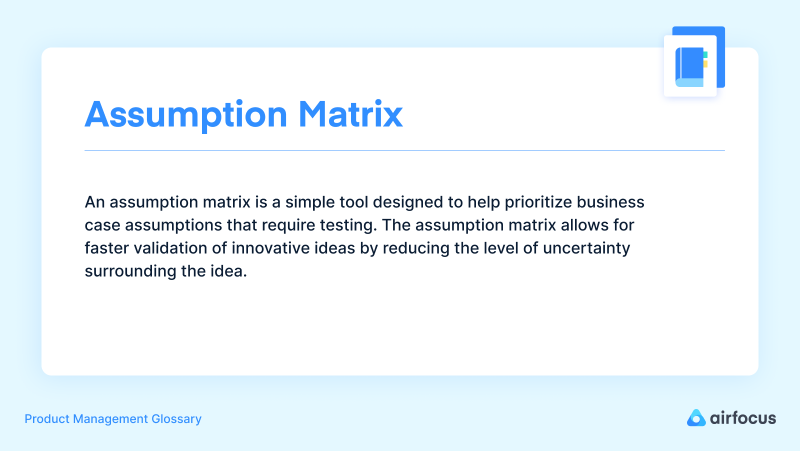Assumption Matrix
Assumption Matrix
An assumption matrix is a simple tool designed to help prioritize business case assumptions that require testing. The assumption matrix allows for faster validation of innovative ideas by reducing the level of uncertainty surrounding the idea.
The process — sometimes referred to as assumption mapping — involves creating a matrix with two dimensions that represent how much effort is required and how the business case will be invalidated if an assumption is false.
Why should you create an assumption matrix?
Using an assumption matrix offers businesses the chance to assess ideas at their earliest stages so that ventures with a higher risk of failure (and/or with little reward) can be weeded out. Let’s look at just some of the benefits an assumption matrix can offer.
The assumption matrix helps reduce guesswork when trying to decide on a new product
By vetting ideas with the assumption matrix, we can begin to see new ideas in a business context. The matrix will pinpoint which ideas are worth pursuing and which should be left behind, eliminating most of the guesswork in this early stage.
The assumption matrix helps you identify any assumptions that might lead to failures
Assumption mapping clearly visualizes which ideas might succeed, which need more work, and which are likely to fail. Ideas that land in the top right of the matrix are worth pursuing, while those in the bottom left should be left behind.
Better still, the assumption matrix helps you better understand why an idea will succeed or fail
Using an assumption matrix doesn't just help us to identify items that may fail, it helps us understand why they may fail. It gives us a better understanding of desirability, viability, and feasibility.
Desirability is the measure of how appealing a product is to your customers. Essentially asking the question “Do our customers need this?”.
Viability refers to how worthwhile pursuing an idea is. Put simply, will an idea generate enough revenue to justify working on it?
Feasibility is about how possible an idea is. Is it possible with the resources you have available?
The assumption matrix helps save resources
Speaking of resources, using an assumption matrix helps businesses stay lean by removing ideas that may fail. Doing this at such an early stage ensures that your teams aren’t wasting time and resources pursuing ideas with little to no promise.
When should teams use an assumption matrix?
The assumption matrix is best used in the early stages of product development. The idea is to identify ideas that are worth pursuing to avoid wasting time and resources on risky ventures. The sooner you can put your ideas into the matrix, the better.
You can also use the assumption matrix to help increase your team’s understanding of the assumptions about a new product idea.
How to create an assumption matrix?
Creating an assumption matrix is simple and can be broken down into five steps.
1. Have everyone write down 4 key assumptions about desirability, viability, and feasibility
The team writes their four most important assumptions about the idea to provide context behind its placement on the matrix.
2. Share your assumptions with the team and build on each other's assumptions
Assumptions are shared and discussed in order to reach a consensus about the idea’s placement.
3. Create a 4-quadrant grid
To create the matrix, we need two axes that intersect in the middle of the chart. On the Y axis, write “critical” at the top and “not critical” at the bottom. On the X axis, write “certain” on the left and “uncertain” on the right.
4. Plot out your assumptions on the grid
Place the ideas on the grid to visually represent the team’s feelings. You’ll instantly be able to see the ideas most worth pursuing in the top right quadrant.
5. Identify which assumptions are critical and prioritize which you want to test
For each of the most viable ideas, ask "if this assumption turned out not to be true, would it kill the product?".
Tips for creating an assumption matrix
Everything you put on the matrix should be based on what you know today
Keep an open mind for new information
Make sure you're getting input from everyone

General FAQ

Glossary categories
Experience the new way of doing product management

Experience the new way of doing product management








